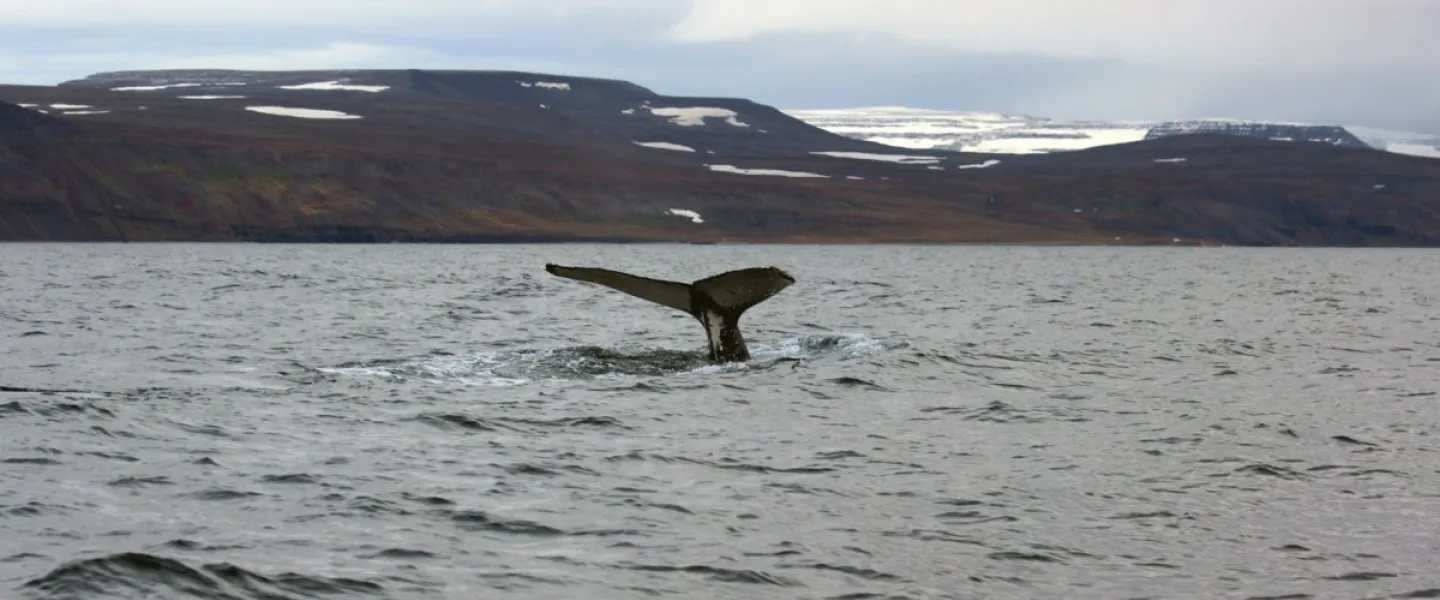
Edda Elísabet Magnúsdóttir, adjunct lecturer at the University of Iceland
Whales have probably always fascinated humans due to their incredible size, their mysterious lives in the depths of the sea, and their unusual intelligence. These things have made whales important to the tourist industry, as well as an inspiration to writers. Many have been thrilled by the tale of Moby Dick, the enormous white whale who dragged his hunters deep below the waves.
But whales are also of interest to scientists, including Edda Elísabet Magnúsdóttir, adjunct lecturer at the University of Iceland. Scientists look at whales from a very wide range of perspectives, and Edda Elísabet's research focuses on the behaviour of the animals. Whales have undoubtedly been living in the sea around Iceland for thousands of years and have been considered a resource ever since the settlement. It is likely that the settlers of Iceland were able to hunt whales, since there is considerable mention of whales in ancient sources. 17 Icelandic Sagas include descriptions of the relationship between humans and whales in the early years of the settlement period. 'Beached whale' is still a term in Icelandic used to refer to a great windfall – in the old days it would have meant an entire larder of food washing up on the beach. The way people used a beached whale, therefore, was once of critical importance and the Jónsbók law codex of 1281 contains a section discussing beached whales. Incredibly, these ancient laws on beached whales still form the basis of current law in Iceland.
Mammals who have adapted to life in the sea
Whales are mammals who are extremely well adapted to life in the sea and can be divided into two categories: baleen whales and toothed whales. There are around eighty species of whale and scientists believe they are probably descended from a common ancestor who returned to the sea 55 million years ago. Whales can range from just under one and a half metres long and roughly 50 kilos up to 34 metre long, 190 tonne behemoths like the blue whale, the largest animal on earth. The humpback whale, the subject of Edda Elísabet Magnúsdóttir's research, is no shrimp either. Humpback whales often exceed 13 metres in length, with the female weighing up to 40 tonnes and the male a little lighter, but still up to 35 tonnes. Humpback whales are also our superiors when it comes to longevity, able to reach almost a hundred years old entirely without medical care.
Humpback whales live around Iceland all year long
"My research focuses on the behavioural ecology of humpback whales with regard to their lives in the North Atlantic," says Edda Elísabet. "I will seek answers to the questions of why humpback whales seem to live around Iceland all year long, what they do during the winter darkness, what their physical condition is at this time of year and other times, whether they can potentially breed here, and what their preferred diet is."
Humpback whales have been classified as migratory animals, since they can be found in all the world's oceans, from the equator to the edge of the polar ice. They do not venture under the ice because, as most people know, they need to surface to breathe. According to scientific theories, humpback whales are supposed to stay in cold waters like the sea around Iceland to feed in the summer, but migrate like the birds to warmer climes in late autumn or early winter to breed. Edda Elísabet has a different, and exciting, story to tell.
"The migratory behaviour of humpback whales observed around Iceland contradicts what scholars have claimed about this species and it appears that we are witnessing behavioural changes," she says. "This knowledge will play a significant role in our understanding of the whales' intelligence in adapting to changing environmental circumstances, as well as their role in the Icelandic marine ecosystem on a year round basis."
Discovered changes in humpback whale behaviour during her PhD
During her PhD, Edda Elísabet began researching the presence of whales around the coast of North East Iceland throughout the year using sound recording devices. "Using the recordings from those three winters, I discovered that humpback whales remained here throughout the winter, singing day and night. The bull humpback whales sing during the winter breeding season at the southern breeding grounds and this behaviour has therefore been linked with the breeding process," says Edda Elísabet.
Her doctoral thesis thus took a new direction and is now entirely focused on the singing behaviour of humpback whales in their habitats around Iceland. "What was missing was further investigation of what they were doing, other than singing. Questions such as what individuals are these, are they sexually mature, are the females also singing, and do they then have the potential to breed. Is Iceland a breeding ground? It became clear that these questions demanded an answer, since the findings of my PhD project indicated humpback whales living different lives than we have previously been aware of."



